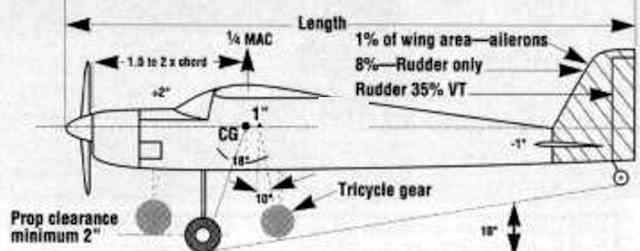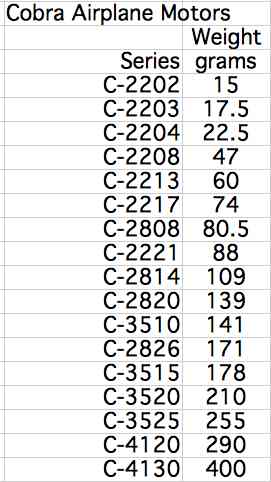Power System for an ARF, Kit or Plans Built Electrically Powered or Glow Conversion Prop Plane By Ken Myers Original date of publication March 2017 Article and Spreadsheet Workbook updated April 2021 Note: There are MANY ways to choose an electric power system for an electrically powered, or glow conversion to electric power, plane.
Selecting a power system for an electrically powered airplane, or converting an originally glow powered, almost ready to fly (ARF), plans built or kit built, prop propelled, model aircraft to an electric power system, may seem like a daunting task to someone with no electric power system experience. "How can the motor, and the other electric power system components, the battery, electronic speed control (ESC) and propeller, be selected by someone with little prior knowledge of electric power systems?" 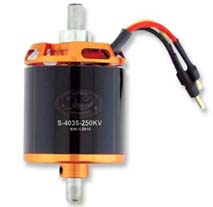
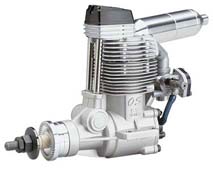 Previously, when glow powered aircraft were the 'norm', selecting an engine and propeller (prop) seemed relatively easy. For many reasons, selecting a power system for an electrically powered plane appears to be much more difficult. When suppliers of glow engine airframes recommend a certain cubic inch (cu.in.) displacement 2-stroke or 4-stroke engine, it was not just a power recommendation. They were not only recommending the engine 'size', but they were also recommending the prop size; its diameter and pitch in inches.
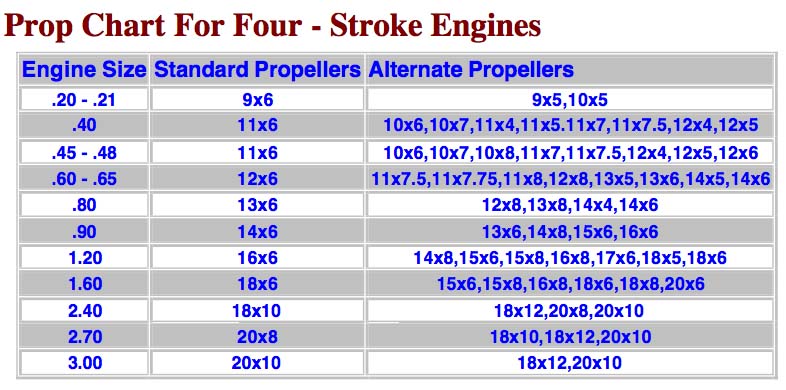
Prop Chart from www.flyurbana.com/media/Chart.PDF A typical sport 1.20 4-stroke might use a 14x8, 15x6, 15x8, 16x6, 16x8, 17x6, 18x5, or 18x6 prop. (See Prop Chart for Four-Stroke Engines.) Various prop brands may 'work better' or 'worse' on a given engine, but the size is quite limited.
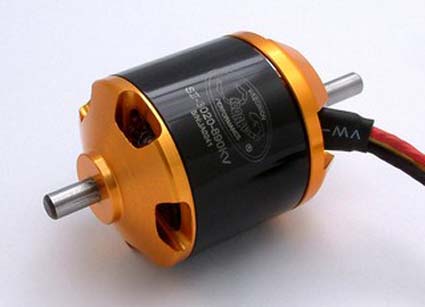 A Scorpion SII-3020-890 (link broken) (3846-890, 166g - See Generic Motor Naming) motor, using a 3S (3 cells in series) LiPo (Lithium Polymer) battery pack, is in its useful power range using an APC 10x7E prop through an APC 15x4E prop with a power range of 275 watts in to 475 watts in. There are roughly a dozen, or more, diameters and pitches that fall within the useful power range when a 3S LiPo battery pack is used. The motor is rated for use with up to a 5S (5 cells in series) LiPo battery. Using a 4S or 5S pack adds a whole array of different props to the mix. There are over 25 different prop sizes that may be useful within the motor's power range of 275 watts in to about 825 watts in. Depending on the prop chosen and battery cell count, the watts in range suggests that this motor can power an airframe designed for a .15 size glow 2-stroke through a .40 size glow two stroke. It all depends on the prop and battery selection. Using packs made with "A123" 2500mAh LiFePO4 cells, instead of LiPo cells, adds even more usable props to the mix! Note: The name/brand A123 Systems cells no longer exists, or "A123". The same cells are now branded as LithiumWerks and sold by Storetronics in Livonia, MI. To keep the process as simple as possible, a Selecting Electric Power Systems .xls workbook, with spreadsheets for LiPo batteries, "A123" 2500mAh cells and "A123" 1100mAh cells, has been designed to use as a guide. Download the .xls workbook from the link. Open the .xls file. If the LiPo tab is not selected, select it. Use the LiPo spreadsheet to follow along as you read through this article. The technique presented here is based on limiting the prop selection. This technique results in a more manageable number of motor and battery choices. First, the required input power, watts in, is determined. The required input power is based on supplier provided information for the airframe. Next the prop size is determined. Finally the rest of the power system components are matched to the prop and airframe power requirements. The desired flight time is also taken into account. The Suggested Input Power unit of measurement is watts in (watts = volts times amps) as displayed by a power meter connected between the battery and electronic speed control (ESC). The measurement is always taken at full throttle. It is Extremely Important to verify that the current (amps) and input power (watts) do not exceed the capabilities of the motor, ESC and battery. Exceeding the capabilities of any of the power system components will cause catastrophic failure to one or more of the power system components! A power meter is essential when working with electric power systems! The Example Model: 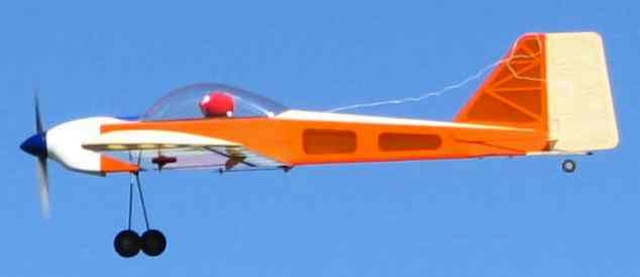
Mountain Models Switchback Senior (a plane designed for electric power) The three spreadsheets in the workbook, one for LiPo batteries and the other two for A123 cells, are designed for user inputs to be placed in the spreadsheet cells with green backgrounds and the results are presented in cells with red backgrounds. The spreadsheet's initial cell input numbers, inputs, are noted in parenthesis, in the following example, and use the airframe manufacturer's or supplier's recommended maximums (Max.). Initial Inputs;
 The Wing Cube Loading (WCL), presented in the results cell (B12), is 4.38. The wing cube loading (WCL) has NO UNITS. It is just a comparative value.
A table on the spreadsheet shows the seven 'flyability' levels for the wing cube loading and what type of 'flying' they are usually associated with. Occasionally, some planes might have a wing cube loading that place them into the flyability levels of 1, 2 or 3, but because of their weight or flying speed, they cannot, and should not, actually be flown in the suggested venue. Keep in mind that the lower the wing cube loading (WCL) value, the "easier" the plane is to fly. The easier a plane is to fly, the more susceptible it becomes to increasing wind speeds.
The Switchback Senior has a WCL of 4.38. That is typical of a WCL Level 2 aircraft, a 'typical backyard flyer'. Even though the 'typical' mission is 'backyard flyer', the example plane is too large for most backyards, and is too heavy to even meet the AMA definition for a park flyer, but it will fly like a 'typical backyard flyer', very easily.  The Suggested Power result is 209 watts in. The weight range for suitable outrunner motors is the first characteristic determined.
The Switchback Senior Manual states, "We recommend a brushless motor rated for around 200 to 300 watts." Unfortunately, the manual offers no suggestion for the prop size. Prop size is noted by its diameter in inches followed by its pitch in inches. For example, a 12x6 is a prop with a 12-inch diameter and a 6-inch pitch. Not all props are created equal! Zinger props should be avoided for electrically powered models, unless you have the skills necessary to turn them into useful props. They are relatively inefficient, compared to other brands, when used in electric motor applications and draw too much current. APC slow flier (SF) props and GWS RS props are not designed for this purpose, sport and sport scale aircraft. They are fine for indoor fliers or aircraft used in light wind conditions. They draw a lot of current, compared to thin electric (E) APC props. APC sport, pattern and thin electric (E) props are appropriate. APC props are listed at www.apcprop.com/product-category/electric-motors/. Master Airscrew wood props and G/F 3 series props also work well in these types of electric power applications, but NOT the Master Airscrew electric props!
The diagram suggests 2" of prop clearance. That usually works well for aircraft with conventional landing gear, which are often called taildraggers, but 1.5" of ground clearance will work with short cropped grass or pavement. On aircraft equipped with tricycle landing gear, the nose wheel gear tends to bend backwards on takeoff and over time. 2" of ground clearance, or a bit more, will work for trike geared aircraft. If a desired prop, based on other criteria, does not have the suggested ground clearance, the plane can be hand launched. There are no plans available for the Switchback Senior online. The prop size was not recommended in the manual. Use whatever resources are available to determine the maximum prop diameter. For the example aircraft, I checked several sources on the Internet. I found "Mountain Models Switchback Senior Review by Bernard Cawley" to be the most helpful. It noted using props with 10" diameters to 13" diameters. 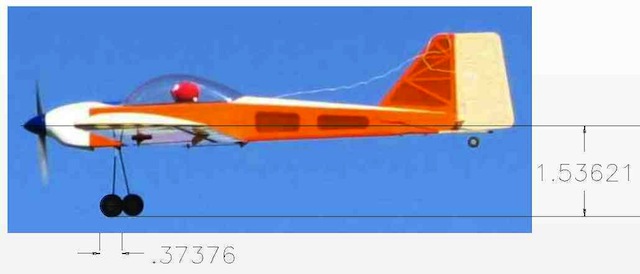 To verify this, a side-view photo of the Switchback Senior was used in a CAD program to guesstimate the 2" of ground clearance for this conventional landing gear plane. The included wheels are DuBro 2". A ratio showed that there was 8.25" between the center of the shaft to the ground. 8.25" - 2" = 6.25". That indicates that a 12" prop can be used, while a 13" diameter prop might be 'pushing' the ground clearance a little. Whether a 12" or 13" diameter is chosen is not super critical, as the watts in will lead to the selection of a usable motor. The idea is to get as large of a usable prop diameter as possible, because as the diameter increases, so does the prop efficiency. APC E thin electric props are used in this motor selection process.  A 12" diameter was chosen for this example and entered into cell B19.  The pitch suggestion box (cells A29 through B31) shows suggested pitches for the WCL levels after the prop diameter is input. The prop diameter, for the example plane, is 12", which was previously input into cell B19. For WCL Levels 1 - 3, pitch to diameter ratios of 50% to 60% are appropriate. For WCL Levels 4 - 7, pitch to diameter ratios of 70% to 80% are appropriate. These are ballpark 'rules'. They are not written in stone. For Cub-like planes, biplanes and other civilian light aircraft with a WCL level of 4, it might be better to use the WCL 1-3 pitches. If more speed is desired of a WCL level 3 plane, a pitch may be chosen between the WCL 1-3 pitches and the WCL 4-7 pitches, or at the lower end of the WCL 4-7 pitches. The Switchback Senior is a WCL Level 2 aircraft. Choosing the recommended low pitch from the table, 6", allows the static current draw to be adjusted slightly up using the higher pitches, if necessary.  A 6" pitch was chosen for the example and input into cell B20. The APC Web site is used to verify that there is an APC 12x6E thin electric (E) prop. The final choice of prop pitch may depend on the availability of possible props, and it may require rounding.  Once the prop diameter and pitch have been input, the resultant Target RPM of 6701, pitch speed of 38.07 mph, and approximate stall speed of 11.05 mph are displayed. The Pitch Speed to Stall Speed ratio of 3.45:1 is displayed. Pitch speeds above 2:1 are good and anything greater than 3:1 is quite good. Pitch Speed Conformation: 
Pitch Speed Table as Shown on the Spreadsheet For reference, the pitch speed table can be used to compare the pitch speed to both average and median electric and glow powered planes. The table indicates that a predicted pitch speed, in the middle to upper 30s, is just about 'right' for this Level 2 electric plane. Recap: 1. The motor for this plane needs to handle at least 209 watts in
The cells, starting at A34, are used to help select appropriate motors. Input the desired flight time in cell B39. 6 was entered for this example.  Rows 34 through 38 review the results of the previous calculations. For the Switchback Senior airframe, look for motors that weigh between 70g and 104g and that can turn an APC 12x6E at 209 watts in, give or take a little. Actual, tested Cobra motor information, presented on the Innov8tive Designs' Web site, is used as a guide for the motor selection. The Cobra airplane motor information starts here. The listing of motors on the Innov8tive Designs' Web page shows the C-2221 series before the C-2808 or C-2814 because the listing is based on a diameter. Each series of Cobra motors has several different Kv values available. The Kv value is the motor's no load RPM value.
1. Open the C-2217/20 960Kv first. It is the lowest Kv value listed for the series.
1a. Open the C-2221/16 940Kv first. It is the lowest Kv value listed for the series.
1b. Open the C-2221/12 1250Kv. It is the second lowest Kv value listed for the series.
1c. Open the C-2808/30 1000Kv first. It is the lowest Kv value listed for the series.
1d. Open the C-2814/20 850Kv first. It is the lowest Kv value listed for the series.
1e. Open the C-2814/16 1050Kv second. It is the second lowest Kv value listed for the series.
The Inputs:
 The Results:

Selecting the Motor from the List 1. It turns the same prop as the C-2221/16 at approximately the same RPM while inputting less watts to do so. This indicates that it is more efficient and drawing less current, while doing the same amount of 'work'.
The Results also show the minimum amp rating for the electronic speed control (ESC). The amp rating presented on the spreadsheet has a 'safe overhead' built into it. Of course a larger than recommended amp rated ESC could be used. The number of LiPo Cells is determined by the motor chosen. For the example plane, it happened to be that both were 3S, but that won't always be the case. The ESC must also be able to handle the number of cells, which determines the voltage, for the pack selected. The Battery (Batt.) mAh is the recommended MINIMUM capacity, rounded to the closest 100, to achieve the desired flight time that was entered in cell B39. A smaller capacity pack could be used, and the flight time would decrease. A larger capacity battery could be used. It would increase the flight time, but also the ready to fly weight. Cobra motors were chosen to help locate an appropriate motor. They are very good motors to use, but YOU can select any brand that has a similar weight and Kv. The C-2221/16 is an 88g motor with a Kv of 940 and the C-2814/20 is a 109g motor with a Kv of 850. A quick search of Heads Up Hobby and MotionRC yielded the following:
They could be substituted for the C-2221/16 and C-2814/20 respectively. My personal experience has been that 'cheap' motors and 'cheap' ESCs do NOT produce system efficiencies as good as Cobra motors paired with good ESCs, but the choice is yours. "A123" 2500mAh cells are 'best' used with planes with a ready to fly weight between 3 lb. and 10 lb. Use the A123 (2500mAh) spreadsheet in the workbook for "A123" 2500mAh cells. All of the inputs, through the prop diameter and pitch, are the same as for LiPo packs. The major difference, when selecting a motor for "A123" cells, is that the results of the spreadsheet calculations are presented BEFORE selecting the motor. Another important difference is that the motor must be rated to handle 35 amps or more when using the "A123" 2500mAh cells. "A123" 2500mAh packs are 'best used' with an amp draw between 33 amps and 38 amps at full throttle. That amp draw yields approximately 100 watts in per cell. During the calculations, the ready to fly weight (RTF) weight is adjusted slightly upwards before the final calculations are performed. This allows for the slightly heavier weight of "A123" 2500mAh cells compared to LiPo cells. 
These are the Results for the Switchback Senior airframe The Results show that the recommended motor weight range is between 67 grams and 100 grams and that the Kv range is between 1335 and 1483.
In the Possible Motor Choices cells, rows 44 through 48, insert the motor name and Kv shown on the Innov8tive Design's Website page that fits ALL of the criteria, including being able to handle 35 or more amps. Click on the link to the possible motor. Check the maximum continuous amp draw and note it in the column for it in the Possible Motor Choices area.  The selection is quite easy as there is only one motor to select from. The ESC for ALL "A123" 2500mAh systems must be able to handle 45+ amps and the voltage shown in cell A39. The number of "A123" cells in the pack is shown in cell B39 of the spreadsheet. The capacity and amp draw are pretty much 'fixed', therefore the typical flight time is six to seven minutes, depending on the pilot's throttle management skill and flying style. "A123" 1100mAh cells are 'best' used with planes with a ready to fly weight between 1 lb. and 3 lb. Use the A123 (1100mAh) spreadsheet in the workbook for "A123" 1100mAh cells. All of the inputs, through the prop diameter and pitch, are the same as for LiPo packs. Again, the major difference, when selecting a motor for "A123" cells, is that the results of the spreadsheet calculations are presented BEFORE selecting the motor. Another important difference is that the motor must be rated to handle 17.5 amps or more when using the "A123" 1100mAh cells. "A123" 1100mAh packs are 'best used' with an amp draw of about 15 amps at full throttle. That amp draw yields approximately 50 watts in per cell. During the calculations, the ready to fly weight (RTF) weight is adjusted slightly upwards before the final calculations are performed. This allows for the slightly heavier weight of "A123" 1100mAh cells compared to LiPo cells. 
These are the Results for the Switchback Senior airframe The Results show that the recommended motor weight range is between 67 grams and 100 grams and that the Kv range is between 694 and 771.
In the Possible Motor Choices cells, rows 44 through 48, insert the motor name and Kv shown on the Innov8tive Design's Website page that fits ALL of the criteria, including being able to handle 35 or more amps. Click on the link to the possible motor. Check the maximum continuous amp draw and note it in the column for it in the Possible Motor Choices area.  The selection of the motor was a bit more difficult. There was not a motor in the weight range with a Kv as low at 771. The 850 Kv motor should work okay, but may have a bit higher amp draw than expected. If the amp draw is "too" high, the prop diameter can be reduced. The ESC for ALL "A123" 1100mAh systems must be able to handle 25 amps and the voltage shown in cell A39. The number of "A123" cells in the pack is shown in cell B39 of the spreadsheet. The capacity and amp draw are pretty much 'fixed', therefore the typical flight time is six to seven minutes, depending on the pilot's throttle management skill and flying style. A second Excel workbook was created for a Sig 4-Star 40. It has been a very popular glow sport plane. The 2nd workbook, containing the 4-Star example, can be downloaded and studied to note the differences when doing a conversion from a glow powered aircraft to an electrically powered one. Download the 4-Star 40 workbook. Servos are NOT directly related to the power system, but they are related to the 'speed' and ready to fly weight of the aircraft. There are articles in The Ampeer Electric Flight Newsletter that can be used as a guide for the servo selection for sport and sport scale aircraft. Open The Complete Ampeer Index and search the page for 'servos'. There is a lot of very useful information to be found there. What to do if Microsoft Excel in not on the computer For computers that do not have Microsoft Excel, the FREE Open Office Suite may be used. I just recently learned that Open Office is almost 'dead', but that it is still available. The new, FREE LibreOffice Suite, compatible with MicroSoft Office, can be downloaded here. WING CUBE LOADING (WCL) by FRANCIS REYNOLDS WING CUBE LOADING, by Roger Jaffe 3D Wing Loadings: a Better Way to Scale Models WCL Calculator online at Electric Flight UK Unlike glow engines, there is no standard way of 'naming' an electric motor. Using a generic name for all outrunner motors allows for direct comparisons. The generic name for the outrunners used in this article is the first two digits indicate the outside diameter in millimeters (mm) with the next two digits noting the can length in mm, then there is a dash followed by the Kv. A comma separates the weight in grams from the rest of the motor description. The Scorpion SII-3020-890, used to illustrate the versatility of an electric outrunner motor, has a can diameter of 38mm, can length of 46mm, Kv of 890 and weighs 166g. Its generic name is 3846-890, 166g. More on "generic" motor naming here |
To Reach Ken Myers via E-mail kmyersefo@theampeer.org
The EFO Web Site

